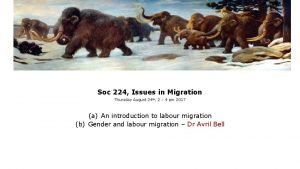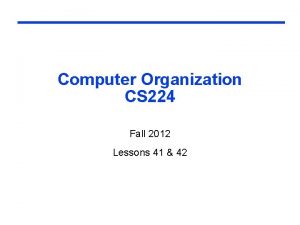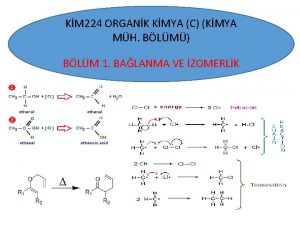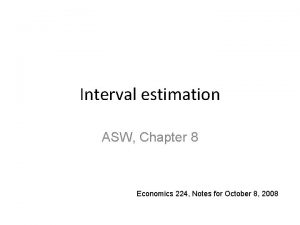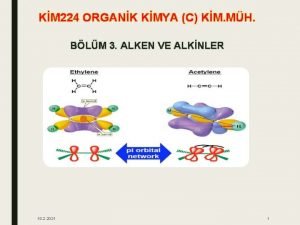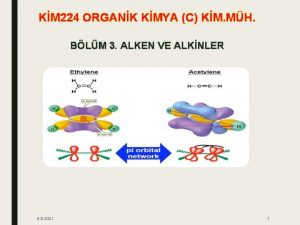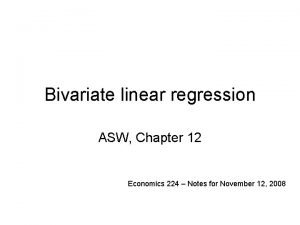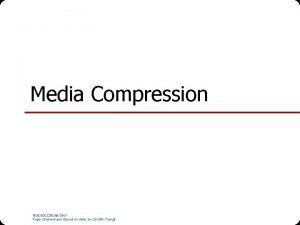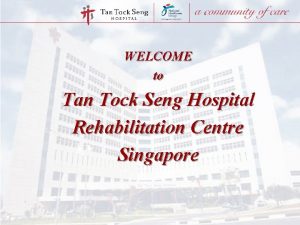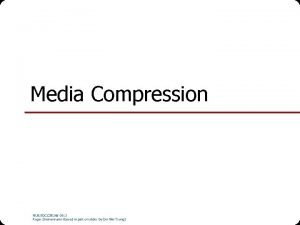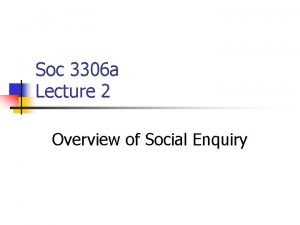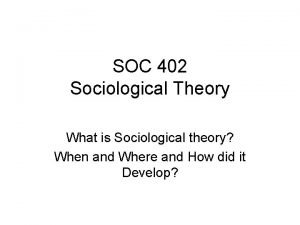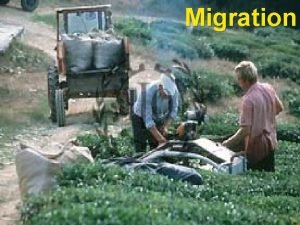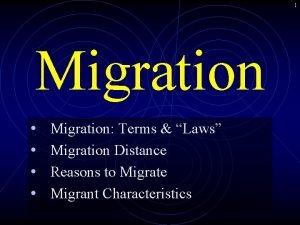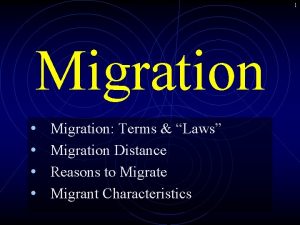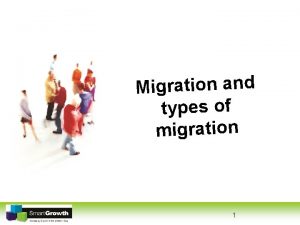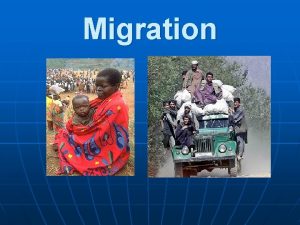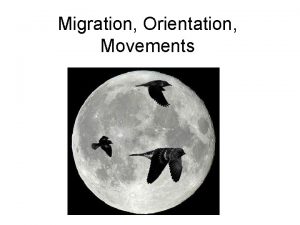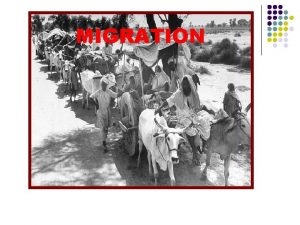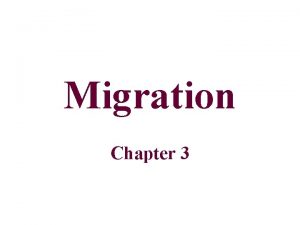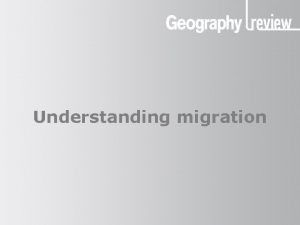Soc 224 Issues in Migration Thursday August 24











































- Slides: 43

Soc 224, Issues in Migration Thursday August 24 th, 2 – 4 pm 2017 (a) An introduction to labour migration (b) Gender and labour migration – Dr Avril Bell

Objectives today: To achieve a summary overview of: 1. patterns of global labour migration. 2. migrants and their role in the economy 3. immigration New Zealand: recruitment of labour migrants 4. resistance to immigration 5. vulnerability of migrant workers. 6. Guest Lecturer Dr Avril Bell: Gender issues and migrant labour

1. Summary overview of global patterns of migration. Global estimates of the stock of International migration is extremely significant in the C 21 st. migrants, migrant workers and migrant domestic workers, 2013 This is expected to continue to increase. This is because of demographic, economic and security trends. Migration takes place when there are economic disparities between source and receiving countries and individual have the capacity or means to move from poorer and less secure paces, to richer and more secure places. Conflict, poverty, inequality and lack of decent jobs are among the reasons that urge people to leave. Globalisation provides information to find work in other countries, and rules about access. Modern transportation makes it easier, cheaper and faster to move. Richer people also migrate, often to earn more in another place. There are few countries without labour flows.

Distribution of migrant workers, by broad sub-region, totals (male + female), 2013

Global labour force participation rates of migrants and non-migrants, by sex, 2013

Age groups of ‘migrant stock’ Most global migrants are of working age. 2015: 72% of all international migrants were aged 20 to 64 years, compared to 58% of the total population. Persons below age 20 are underrepresented amongst international migrants. Globally, 15% of all migrants were under 20 years of age, compared to 34% of the total population. Aged 65+: 13% of migrants worldwide were at least 65 years old, nearly twice as high as the percentage of persons aged 65 or over globally. This difference is due to a combination of factors, including the fact that, upon arrival, the majority of international migrants are of working age. They stay, they age. Note 1: International migrant stocks include not only newly arrived immigrants but also migrants who have lived in a country for many years. The median age of immigrants when they arrive is, on average, considerably lower than that of the migrant stock Question: when is a migrant no longer a migrant? Is a migrant always a migrant? Note 2: Pattern: the return home of many migrants at older ages .


Useful resources Interactive map: Https: //www. iom. int/world-migration Excellent summaries of global labour migration, with graphs: (a) ILO: International Labour Organisation, Geneva, 2015 Full report: ILO global estimates on migrant workers 15 Dec 2015 (b) International Migration Report, 2015. The Department of Economic and Social Affairs of the United Nations Secretariat.

Labour migration is difficult to manage because it takes place in an arena of constant change in (a) the skills and characteristics of migrants themselves (b) the host society and the wider economy. Further Complications: Migration can be affected by economic, environmental, geopolitical, security and health crises. Geopolitics: 1. combination of geographic and political factors influencing or delineating a country or region. 2. a national policy based on the interrelation of politics and geography.

Foreign workers wanted! Not all labour migration targets highly skilled workers Some countries want foreign workers in medium and low skilled occupations. Some countries base admissions on employer demand, balanced with numerical limits. Eg Germany and Canada have recently developed provisions for medium skill workers, especially for trades requiring apprenticeships, where shortages are current or expected. Migrants fill important niches both in fast growing and declining sectors of the economy. Like the native born, young migrants are better educated than those nearing retirement. Migrants accounted for 47% of the increase in the workforce in the United States and 70% in Europe over the past ten years.

USA

Corresponding map: migrants country of origin, by state

Temporary labour migrants • Alongside permanent migrants there also significant movements of temporary labour migrants. • These include seasonal workers staff transferring within multinational companies people on working holidays. • Temporary labour migrants often become permanent migrants • Most labour migrants start with a temporary authorisation for employment that eventually becomes permanent. • • This is called two step migration. It is now the norm in most countries. This is true in Europe where migrants’ rights typically increase with duration of stay. It is also increasingly true in the traditional settlement countries Australia, Canada, New Zealand the United States.

Access for migrants: the walls

*OECD, 2014: Migration Policy Debates. Benefit or burden? ‘The economic impact of migration has been intensively studied but is still often driven by ill- informed perceptions, which, in turn, can lead to public antagonism towards migration. These negative views risk jeopardising efforts to adapt migration policies to the new economic and demographic challenges facing many countries. ’ 2. Migrants affect the economy in three main areas: a. The labour market • Migrants: 47% of the increase in the workforce in the United States and 70% in Europe over the past ten years. • Migrants fill important niches both in fast growing and declining sectors of the economy. • Like the native born, young migrants are better educated than those nearing retirement. • Migrants contribute significantly to labour- market flexibility, notably in Europe. • *OECD: Organisation for Economic Co-operation and – an intergovernmental economic organisations, 35 member countries, founded in 1960 to stimulate economic progress and world trade. A forum of countries describing themselves as committed to democracy and market economy. Most OECD members are high income economies.

b. Work and taxes Migrants contribute more in taxes and social contributions than they receive in benefits. • Labour migrants have the most positive impact on the public purse. • Employment is the single biggest determinant of migrants’ net fiscal contribution • c. Economic growth • Migration increases the working age population. • Migrants arrive with skills and contribute to human capital development. • Migrants contribute technological progress.

3. Immigration New Zealand: recruiting labour migrants to New Zealand. Advice about Recruitment, 2017. The Government recently announced changes to the Skilled Migrant and Essential Skills policies, aimed at striking the right balance between ensuring New Zealanders are at the front of the queue for jobs while preserving access to the temporary migrant skills necessary for New Zealand’s continued economic growth. ADVICE Getting ready to hire overseas workers • If you can’t find a New Zealand worker for a vacancy, you may be able to recruit a migrant. Here are some things you can do to prepare yourself for hiring overseas candidates. • Hiring from overseas will not suit every employer. It takes patience and perseverance and can be more complex, costly and time-consuming than hiring locally. • When preparing to hire overseas workers, you should consider the extra costs that can be involved with hiring overseas. These may include advertising, possible overseas travel and potentially, relocation costs. • This section has tips for hiring overseas workers and identifying issues and challenges that may not be part of your everyday recruitment activities.

Immigration N Z website: • Job market & key industries • Is it a good time to be looking for jobs in New Zealand? Definitely - especially if you have the right skills. • New Zealand was less affected by the global financial crisis than many other countries and employment has been gathering steam, particularly in the last three years. However, while employment conditions are expected to remain strong, the Government forecasts the growth rate will decline for the next three years to 2018. • There are many job openings for specialists in industries such as medicine, engineering and IT. But there also opportunities to contribute more generalist skills.

NZ Long Term Skills Shortage List Feb 27 th 2017 • Forestry • Construction • Engineering • Finance/ Business • Health – esp medical specialists • Electronics / communications • Scientists • Motor trades

NZ: Immediate skills shortage list Similar to above, but also • agricultural workers; • farmers – dairy, beef, pig, poultry • apiarists • Arborists • Wine makers • Recreation, hospitality and tourism workers • More trades: bakers, bricklayers, floor finishers, glaziers, metal workers, plastics workers, scaffolders. NOTE: Qualifications listed (unless an exception is stated) are New Zealand awarded qualifications on the New Zealand Qualifications Framework (NZQF). Overseas qualifications must be comparable to the standard of the New Zealand qualification listed. Overseas qualifications therefore require an International Qualification Assessment (IQA) from the New Zealand Qualifications Authority stating the comparable NZQF qualification.

• If your occupation is on this list it means that you are eligible to apply for a resident visa under the Skilled Migrant Category. This is a points-based visa that considers factors such as age, work experience, your qualifications and an offer of skilled employment. • To apply under the Skilled Migrant Category you must be aged 55 or under, meet the skill level for your occupation, and meet English language, health, and character requirements.

Migrants 'crowding out' young Kiwis from jobs - Salvation Army By: Simon Collins NZ Herald October 19 th, 2016 An "explosion" of immigrants is "crowding out" young Kiwis from available jobs, the Salvation Army says. A report on youth unemployment by the army's social policy analyst Alan Johnson, using Statistics NZ figures, says immigration of young people aged 15 to 24 has "exploded" from a net gain of 3217 in the year to June 2013 to a net gain of 22, 064 in the latest June year. Yet 74, 100 young Kiwis aged 15 to 24 were not in employment, education or training (NEET) in the year to June - a number that has stalled since a drop from 87, 000 in 2010 to 72, 100 in 2014. "The persistent numbers of 15 to 24 -year-olds who remain outside of the workforce as total job numbers grow, and as young migrants enter New Zealand to take these jobs, suggest this immigration is crowding out more marginalized workers, " the report says. It recommends tightening immigration rules further beyond last week's Government decisions to raise the points required for granting residence to skilled migrants and close the parent category. The report says too many work visas are being granted in four sectors where young Kiwis could be finding work: building, dairying, hospitality and aged care. "It seems timely to consider planning for the future labour demand of these four sectors, " it says. Work visas were approved in the year to June for 1005 aged or disabled care workers, at least 2846 building trades people and labourers, 3129 dairy farmers and farm workers, and at least 8245 people in hospitality jobs, including 4218 chefs.

The sub-replacement fertility club N Z is in a period of population growth. But the composition of New Zealand's population is also changing rapidly. Bill N There are three key contributors to this: structural ageing, fertility rates and immigration. Bill English: youngest of 12 siblings; Mary eldest of 13. They are parents of 6 children. In New Zealand, people aged over 65 = 600, 000+, and set to double. 2015/16: $12. 2 billion - New Zealand OAP. Fertility rates are declining. Statistics New Zealand: 1608 fewer births in 2016 compared to 2015. The total fertility rate is now below replacement levels at 1. 87 births per woman. (Replacement level is 2. 1) New Zealand has joined other OECD countries in the sub-replacement fertility club – the numbers being born are not sufficient to replace the existing population. Such trends can have significant economic impacts, including lack of workers. Why has this occurred? Hypothetically, what could increase the fertility rate? Would this be a preferable option to immigration? Why not? Example: Japan, the first modern country to see a decline in its total population. More than 25% of people are now aged over 65. There are significant labour market shortages as the prime working age population declines. 40% of the country's cities have lost population since 2012.

Support for migrants • The western world has an aging population. • This is especially notable in Europe, with the lowest birth rate ever. • In countries of destination, migrants often fill critical job shortages. • Who will look after the elderly, work in factories, invest in small businesses, educate and train themselves: migrants and diaspora, who also send home money to support families. • They contribute taxes. • They contribute skills and innovation in science, medicine and technology. • They add cultural diversity. • They may be some of the most dynamic entrepreneurs in their new society.

Europe By 2030, there will be 18 million fewer working age people in Europe. Immigration already drives E. U. population growth. The number of foreign-born in the E. U. will be about 20% in 2035. But caution: experts advise that if migration remains as poorly managed as it is now, and the public’s antimigration attitudes are sustained, the already toxic brew of anti-migrant sentiment will likely increase. Suggestions from The International Organization for Migration (I. O. M. ) • Governments need well-designed, far reaching policies to assist with their integration into societies and combat xenophobic or antimigrant sentiment. • Need to Create more legal channels of migration (and thus eliminate people smugglers). • Expand the use of humanitarian visas, provide temporary protective status, short-term visas, seasonal visas, circular migration visas and portable social welfare benefits. • Provide more alternatives for those fleeing conflict to settle in safe countries: better asylum, temporary relocation, resettlement and integration. • • Educate the public to reduce xenophobia and explain that migrants who are integrated and educated benefit society. • • To maintain public confidence in the system, dissuade unqualified migrants from jumping the queue by having voluntary return programs for those who will not qualify for asylum.

Resistance to migrants: commonly voiced objections?

4. Resistance to migrants: commonly voiced objections • job competition • burdens on education and social services • negative environmental impact from accelerated population growth • pressure on housing • increased crime rates (yet research suggests that this tends to be overestimated). • changes in traditional identities and values • Importation of customs and practices that may influence the native country's culture, colliding with established norms, laws and values in genera l eg environmental issues. • Immigrants (and cross-border movement) can import infectious diseases uncommon to the native population. • Immigration may be the response to problems in the migrants' countries of origin. Immigration may not address these problems. • Immigrants may isolate themselves in their own communities, forming self-organized communities, rather than assimilating to the native culture. They might not learn the local language and might eventually undermine the national unity, as well as the cultural and religious unity of the native country.

Resistance to migration One Nation: Pauline Hansen 2016 Hansen voted to represent Queensland in the Australian Govt Senate . • • Feb 21 st, 2017 • It is standing room only at the Buderim Tavern as a crowd of 200 strain to hear Pauline Hanson rail against immigrants, foreign companies, the mistreatment of farmers and the “Islamisation of Australia”. • Flanked by supporters wearing T-shirts and badges bearing the name of her One Nation party, the fiery politician says people are sick of being tagged “racist” for expressing what she says are legitimate concerns.

• “I want to block more Muslims coming in. Look at what has happened in England, it is a hell of a mess, and in France. You have no-go zones, where you aren’t even game to go anywhere near them because they are Muslim dominated. ” • Ms Hanson’s anti-immigrant rhetoric and dubious claims resemble those of US President Donald Trump, Marine Le Pen, the leader of France’s National Front, and Nigel Farage, the former head of the UK Independence party, who have tapped into a wave of popular discontent among mainly white, working-class voters in the US and Europe. • In rural towns such as Buderim in Queensland, a state with a history of conservatism and where good jobs are scarce, wages flat and houses unaffordable for many young people, her populist message is resonating with voters. One of the key argumentsis that it is taking jobs from local workers. Plus investment in infrastructure has failed to keep pace with a population growing at about 1. 5 per cent a year. • Some analysts worry that One Nation’s populist appeal will push the main parties further to the right and undermine its openness to skilled migration and free trade. ‘She wants to take Australia back to the 1950 s. She wants a white, protectionist, illiberal nation. ’ Author Duncan Mc. Donnell, Populists in Power). • Numerous other examples…

5. Vulnerability of labour migrants • Migrants are among the most vulnerable members of society. • They are often the first to lose their job in an economic downturn, often work for less pay, for longer hours, and in worse conditions than national workers. • While for many migration is an empowering experience, others endure human rights violations, abuse and discrimination. • Migrants, particularly women and children, are often victims of human trafficking and the forms of exploitation that human trafficking entails. • In many parts of the world, migration remains one of the few options for people, particularly young people, to find work, and to escape poverty, persecution and violence.

Migrant Workers Alliance for Change Canada

United Arb Emeritus: Dec 22 nd, 2016, The Guardian. Trade unions, human rights activists and politicians have called for urgent labour reforms to protect the thousands of migrant workers building a complex of five-star hotels and museums on Saadiyat Island in the United Arab Emirates, including a new Louvre and the world's largest Guggenheim. The International Trade Union Confederation and activism group Gulf Labour have urged the western institutions involved in the project, including the British Museum, to actively address the workers' welfare and press the UAE government to improve their conditions. The calls come as an investigation found evidence that the Emirate's tourism development and investment company (TDIC), which runs Saadiyat, is failing to uphold its own employment policies, with workers left destitute, confined to their quarters and sent home for taking strike action. Migrant labourers building New York University's Abu Dhabi campus on the island were found to be suffering even worse mistreatment.


• UAE • The investigation reveals that: • ■ Companies are withholding the passports of migrant workers, trapping them in the UAE. • ■ Thousands of workers livw in substandard or squalid conditions in the UAE in apparent breach of the TDIC's pledge to house them all in its model Saadiyat accommodation village. • ■ Dozens of workers were deported this year for striking over pay and conditions. • ■ Workers decorating the university live in squalid conditions, with 10 men to a room, no free healthcare and some trapped because they have to pay back huge recruitment fees. • A worker who claims he lost his leg while building luxury villas has been forced to live on the top floor of a migrant camp for a year. He only received a prosthetic leg last month and has been reliant on the Red Crescent for medical support. His claim for compensation and request for ground-floor accommodation have been rejected. • ■ Louvre workers are having to work for nine months to a year just to pay back their recruitment fees. One worker who went on strike over poor wages was kept in his camp unpaid for three months and then sent back to Pakistan with 19 others.


Migrant work is risky. Thousands of Bangladeshi workers have died working in Middle Eastern countries. More than 8, 000 bodies were returned to Bangladesh from 2004 to 2009, out of roughly 3. 7 million Bangladeshi workers in Saudi Arabia, Kuwait, Qatar, United Arab Emirates, Bahrain and Oman in 2009. Employers often subject workers to inhumane working conditions and hold them hostage by confiscating their passports. Washington Post, May 19 th 2017

Remittances Bangladesh has a long history of migration. After Bangladeshi Independence, 1971, unemployment rose rapidly. The Gulf needed for oil field workers. This led to mass migration to Middle Eastern countries. A job in Saudi Arabia or Dubai became the dream. These work periods were the route to higher economic and social status. Families of migrants were wealthier, therefore migrant work a mark of success.

Remittances • In 2014, migrants from developing countries sent home an estimated US $436 billion in remittances; a 4. 4 percent increase over the 2013 level (World Bank, 2015). • This is far more than official development assistance and aid programmes, and (excluding China) foreign direct investment. • This money is usually to improve the livelihoods of families and communities through investments in education, health, sanitation, housing and infrastructure.

Desperate migrants • Missing Migrants Project tracks the deaths of migrants along migratory routes across the globe. Due to the nature of irregular migration, all data are estimates only.

Recorded migrant deaths by migrants' region of origin, 2017

Illegal immigration: the illegal entry of a person or persons across a country's border, in a way that violates the immigration laws of destination. Reminder: they may already be living and working in that country (Lect 3). There were 11 million unauthorized immigrants in the U. S. in 2015. The U. S. civilian workforce includes 8 million unauthorized immigrants, accounting for 5% of those who were working or were unemployed and looking for work. A rising share of unauthorized immigrants have lived in the U. S. for at least a decade: about twothirds (66%) of illegal immigrants. Image: what we see on media news.

NEWS COVERAGE The Telegraph, June 16 th, 2017 Up to 250, 000 people drop off the radar and end up as illegal immigrants in Britain every year, according to secret Home Office figures, amid warnings that border controls are completely ineffective and will only get worse after Brexit. Where are Europe’s illegal migrants coming from? Surprise: It’s Bangladesh. The Washington Post, May 19 th 2017 The European migrant crisis is a term given to a period beginning in 2015 when rising numbers of people arrived in the European Union, travelling across the Mediterranean Sea or overland through Southeast Europe. The most recent official figures show net migration – the difference between those leaving and arriving in the UK lawfully – stands at 273, 000. Pictured: migrants in Calais earlier this year. June 16, 2017.

Concluding comments: • Most public discussion seems to be about the receiving end of migration • This does not explain the causes and consequences of migration at the sending end. • Lecture 6, August 31 st Migration and Tourism, will provide sociological case studies of labour migration in the tourism industries.
 Soc1 and soc2 vs soc3
Soc1 and soc2 vs soc3 Soc 224
Soc 224 Item 224
Item 224 Disguised meaning
Disguised meaning Mat 224
Mat 224 Cs-224 computer organization
Cs-224 computer organization Aditia apei la vinilacetilena
Aditia apei la vinilacetilena 224+48
224+48 Km 224
Km 224 Asw 224
Asw 224 224-176
224-176 Ece 224
Ece 224 Cs 224
Cs 224 Autoencoders
Autoencoders Aci224
Aci224 Uç alkin nedir
Uç alkin nedir Seal ring vlsi
Seal ring vlsi Phys 224
Phys 224 Dea number
Dea number What is 224 in binary
What is 224 in binary Anaphora
Anaphora Kohlberg stages
Kohlberg stages Oktatetraen
Oktatetraen Km 224
Km 224 Iso tc 224
Iso tc 224 Bivariate linear regression
Bivariate linear regression 224+48
224+48 Stanford cs224
Stanford cs224 Nus soc ffmpeg
Nus soc ffmpeg Nus soc course schedule
Nus soc course schedule Tan tock seng rehabilitation centre
Tan tock seng rehabilitation centre Xilinx soc
Xilinx soc Ibm x-force
Ibm x-force Mag paed soc
Mag paed soc Nus proxy
Nus proxy Https://slidetodoc.com/cc-ngun-m-c-chung-c-im-g/
Https://slidetodoc.com/cc-ngun-m-c-chung-c-im-g/ Nus soc ffmpeg
Nus soc ffmpeg Soc
Soc 1960s socs fashion
1960s socs fashion Soc cissp
Soc cissp Mẫu lập kế hoạch chăm sóc
Mẫu lập kế hoạch chăm sóc Soc 402
Soc 402 Modern siem
Modern siem Sonicjs
Sonicjs

